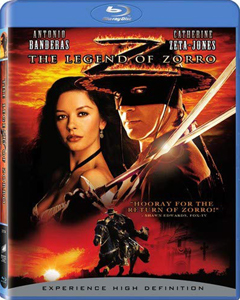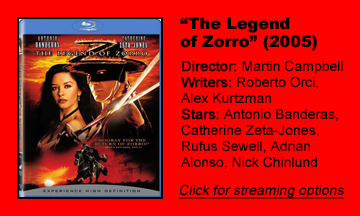The origin story of Zorro (Antonio Banderas) is told in “The Mask of Zorro” (1998), and in sequel “The Legend of Zorro” (2005) wife Elena (Catherine Zeta-Jones) wants him to hang up his sword, mask and hat for good. It seems like there should’ve been a series of films in between, but there weren’t.
As Bruce at Hero Movie Podcast correctly points out, seven years is an awkward gap between original and sequel – you should ideally strike while the iron is hot (a couple years later) or wait till it heats up again (about 20 years later).
Under the radar
No one talked about “The Legend of Zorro” in the year of “Revenge of the Sith,” “Batman Begins,” “Harry Potter and the Goblet of Fire” and “Serenity,” and few in America saw it (it was a much bigger hit worldwide). But Banderas, Zeta-Jones and returning director Martin Campbell don’t phone it in.
All of the positive attributes of the original are here, namely a gorgeous recreation of mid-19th century California and expertly crafted action – both of the big-crowd variety and mano-a-mano fencing.
And again, we get history and science lessons that might not adhere precisely to how it really went, but it might have you diving into Wikipedia. Strikingly, considering today’s increasingly loud push for California secession, “The Legend of Zorro” paints California’s joining with the Union as its 31st state as the be-all, end-all for the common man.
This is simplistic and ironic, but Roberto Orci and Alex Kurtzman (both known for their work on J.J. Abrams projects) don’t point that out (aside from one brief mention that the USA needs California to help with the Civil War effort); they’re working in the family-friendly vein.
Old-school spectacle
The film opens with wooden-toothed bandit McGivens (Nick Chinlund) trying to break up a statehood vote in San Mateo. As silly as the villainous scheme seems on paper, Campbell (“GoldenEye,” “Casino Royale”) appropriately pitches the tone as sweeping, old-Hollywood spectacle.
And it gets even grander, as we learn a secret society aims to produce nitroglycerin bombs out of soap bars, then deliver them to the South so it can win the Civil War and shatter the United States.
As French-bred Count Armand, Rufus Sewell looks like Banderas if you squint, but with a slimy sheen. Elena has broken up with Don Alejandro/Zorro and gone back to Armand, whom she knew back in Europe. She’s not really in league with Armand; she’s actually working undercover for Pinkerton (proto-FBI) agents – one of whom is “Lost’s” Michael Emerson.
The intrigue in these “Zorro” films is deep enough that you have to pay attention, yet too shallow to make following every step satisfying.
The arcs aren’t well-served, either. Elena leaving Alejandro because he spends too much time being Zorro is a groaner of a cliche, and son Joaquin’s (Adrian Alonso) failure to recognize his dad is Zorro is a rote superhero genre necessity.

These movies’ strength is the action, nicely spiced with touches comedy and the occasional one-liner. At one point Zorro’s horse Tornado, atop a train car, widens his eyes in surprise as the train comes upon a tunnel.
Family friendly action, comedy
Even more so than in “Mask of Zorro,” you can bring the whole family to this one. Tornado steals scenes with his various human-like moments, including drinking and smoking a pipe. I admit I went with it.
Among the humans, Joaquin — face-blindness aside — is rather cute as he unwittingly takes after his dad, using martial-arts-type skills against adult bad guys. Armed with a slingshot like an 1850 Bart Simpson, Joaquin rebels against his overbearing teacher (Tony Amendola) in a fun segment.
Alonso has continued to act in Mexican TV, and he’s about the right age to take up the reins as the next Zorro, if someone wants to dig up a post-Civil War California plot, or maybe something in Mexico.
The iron doesn’t seem to be heating up again for this franchise, though. Even when watching Campbell’s two “Zorros,” it’s hard to care about this proto-superhero the way we do about Christian Bale’s Dark Knight and other cinema stars with pop-cultural immediacy.
The actors, designers and choreographers bring their A-games, but it’s in the service of showmanship more than stakes, and the history and science are there to set the stage for the action. Like the original, “The Legend of Zorro” is thoroughly well made but doesn’t quite hook me.


